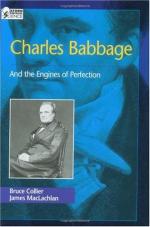|
This section contains 913 words (approx. 4 pages at 300 words per page) |

|
The British scientist Charles Babbage (1791-1871) designed mechanical calculating machines many years before the computer age. Babbage lived during the Victorian era, when mathematicians compiled huge books of tables for use in multiplication, division, and finding logarithms, square roots, etc. The tables were expensive and tedious to prepare and inevitably contained mistakes. Babbage wanted to build a machine that would automatically calculate and print the values for such tables.
In 1821, he began work on his first computing machine, Difference Engine No. 1, which was designed to add, subtract, and solve polynomial equations using the method of finite differences. This method is best illustrated with an example. Consider the equation x3. This is a third order polynomial. The values of x3 for x=1 to 5 are as follows:
Taking the first set of differences between x3 values (i.e., 8-1, 27-8, 64-27, and 125-64) provides 7, 19, 37, and 61. Taking the second...
|
This section contains 913 words (approx. 4 pages at 300 words per page) |

|


